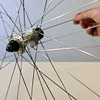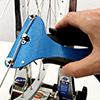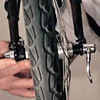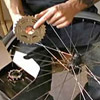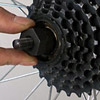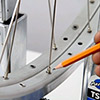How to True a Wheel
Aspects of wheel truing covered include radial, lateral, centering (or dishing) and spoke tension.
Wheel truing is a delicate procedure that requires time and patience. In this tutorial I’ll try and demonstrate the many aspects as clearly as possible. Ideally you’ll want to have a wheel truing stand, good lighting and a comfortable workspace.
Wheel Truing Tips
If you don’t have a truing stand, lateral, or side to side adjustments can be done using your brake pads as a guide. If truing the wheel on your bike, be sure to deflate the tire before you begin. For radial, or up and down adjustments, you can use an L-square as a guide by attaching it to your fork or frame.
It is very important to use the correct size spoke wrench to avoid stripping the spoke nipples.
Before you begin, carefully inspect your wheel for any bent or broken spokes. Make sure your hub bearings don’t have any play and then carefully squeeze a drop of light oil into all of your spoke holes.
Spoke nipples have a regular right-hand thread, but that while you’re truing a wheel, you will be looking at the nipple upside-down, so you have to turn the spoke wrench clockwise to loosen and counter-clockwise to tighten.
Make sure the spoke doesn’t turn with the nipple, which will cause it to twist and break. If it does turn, apply some light oil to the nipple threads and try again.
If a spoke does break while you’re truing, it’ll shoot out the spoke hole with great force, so be careful not to place your face in line with the rim. Safety glasses are highly recommended.
Radial (Vertical) Adjustments
To check radial alignment, place the guide near the highest point on the outer edge of your rim. Find the high spots in your rim by spinning the wheel and correct them by tightening both left and right side spokes evenly. Correct any low spots by equally loosening the spokes in the effected area.
Tighten or loosen spokes in 1/4 turn increments. For example, if the effected area spans the length of four spokes, tighten all four spokes 1/4 turn, and then tighten the middle two spokes another 1/4 turn. Then re-check the radial alignment and repeat the process as needed.
Lateral (Side to Side) Adjustments
To check lateral adjustment, place the guide close to the rim sidewall and look for high spots on either side. To correct a left or right high spot, tighten the spoke that leads to the opposing hub flange and equally loosen the spoke that leads to the hub flange on the same side as the high spot.
Just like radial adjustments, tighten or loosen the spokes in 1/4 increments. Again if the effected area spans four spokes, loosen and tighten all four spokes 1/4 turn, and then loosen and tighten the middle two spokes another 1/4 turn.
Re-check the lateral alignment and re-adjust as needed. Remember that on the rear wheel, the right side spokes have a lesser angle and effect lateral movement less than the left. The left side spokes have greater angle and effect radial alignment less than right. To compensate for this difference, the right side spokes should be adjusted two turns for every turn on left.
Centering (Dishing)
Rims should be exactly centered between the axle nuts. To check this you can use either a dishing tool, or your frame to check the measurement on each side.
If the rim is off-center, pull it in either direction by equally tightening all of the spokes on one side 1/4 turn, and loosening all of the spokes on the other. Then check the alignment again and repeat the process until the rim is centered.
Spoke Tension
To check spoke tension, pluck each spoke in the middle and listen to the sound. On the front wheel, all of the spokes should sound the same on both sides. On the rear wheel, each side should sound slightly different, but the spokes on each side should sound the same as each other.
Most people don’t have a spoke tensiometer, so it’s a good idea to compare the sound of your spokes to the sound of a wheel that you already know has proper tension. Remember that spoke changes effect the whole wheel, so you might have to repeat these steps several times before it is true.
Stress-Relieving Spokes
After the wheel is true you should always pre-stress the spokes and re-adjust before riding. Failure to do this could cause broken spokes later. There are two ways to do this. The first way is to squeeze together the parellel spokes on both sides of the wheel. The second method involves resting the wheel sideways on the floor and gently pushing down on both sides of the rim, all the way around the wheel in 1/8 increments.
After pre-stressing the spokes you will usually have to re-check and make some minor adjustments. If after stressing the wheel you notice that your rim is severly warped, it means that your spoke tension is too high. Loosen all of the spokes 1/2 turn and re-true the wheel.
Related Links
- Jim Langley: Wheelbuilding
- Park Tool: Wheel and Rim Truing
- Park Tool: Wheel Tension Measurement
- Sheldon Brown: Truing Wheels
- Bicycle Torque Specifications
Recommended Tools
- Park Tool SW Spoke Wrenches
- Park Tool SW-7 Triple Spoke Wrench
- Park Tool SBC-1 Spoke, Bearing, and Cotter Gauge
- Park Tool TM-1 Spoke Tension Meter
- Park Tool TS-8 Home Truing Stand
- Park Tool TS-2.2 Home Truing Stand
Categories
Discuss this topic in the Bicycle Repairs and Mechanics Forum
Specialized expedition in need of repair
Latest post 22 hours agoHello I have recently pulled my 2005 specialized expedition out of the garage. It's in need of some repair due to it being damaged by super storm sandy. My shed was flooded with ocean water. The frame itself looks perfect but the moving parts have some rust. Including the fork, brakes, and gears. I'm just looking for replacement parts I have no intentions on buying a new bike. Please help than...
Read moreRear hub issue
Latest post 5 days agoI have a 10-year-old 105 rear hub, and one of the pawls is acting up, I cleaned it and relubed the hub pawls but it still won't engage as fast as it did, like one of the pawls isn't working. I think it might be time to get a new hub. I would like one that engages faster but don't want to spend the money for something like the DT Swiss hub, what recommendations do any of you have for a hub? Or i...
Read moreTyres keep popping off wheels...
Latest post 1 week agoHello guys Just bought a new pair of 700c hybrid wheelset with an inside rim width of 19mm. I have tried to fit schwalbe 700 x 40c tyres on them but the tyres just pop out from the rim when inflated. It seems to be a loose fit. Somebody please advise. Thanks...
Read moreWhat tools have you bought recently?
Latest post 2 weeks agoI'm slowly eliminated all LBSes in my area as options for servicing, LOL. The latest one has been struck off my list after watching, pained, their approach to removing the axle end caps from a hub with cartridge bearings. Suffice to say, I finally ordered a blind bearing puller kit and a bearing press kit. If you want something done properly, you have to do it yourself! Have you bought any nic...
Read moreModern rims crack at spoke holes
Latest post 2 weeks agoRecently, I was in one of the local bike shops. Someone had brought a bike back to have the back wheel re-trued. There were actually cracks in the rim, originating from the spoke holes. I have had the same problem with my bike. In past decades you could buy a bike, and the wheels were strong. With modern rims, the aluminum is getting thinner and thinner. Now the rims crack. With heavy riders, a...
Read moreAre all folding tyres made of Kevlar bead?
Latest post 3 weeks agoHello guys I understand cheaper regular tyres are made with a steel wire bead. But are all folding tyres made of Kevlar bead? I have just purchased a set of tyres as per attached photo and wanted to know if the bead is Kevlar. Can anybody please help? Thanks...
Read moreTire bead won’t seat into rim
Latest post 3 weeks agoI bought a Tamobyke V20. Both the front and rear tire beads slide off the rim when inflating much at all. How do I get them to sit in there where they belong? Pics attached ty!!! IMG_3164.jpeg (Size: 61.62 KB / Downloads: 42) IMG_3173.jpeg (Size: 46.46 KB / Downloads: 41) ...
Read moreHeadset overtightening
Latest post 3 weeks agoI have a Fondriest and could not get the headset to tighten without over tightening and then it will not steer properly because of heavy drag on the bars. I replaced the headset with no change so I replaced the steel fork with s Hylix carbon fiber bar and another new heatset and pinch steering head lock. Still it wont adjust properly. it acts as if the bottom headset bearing is too deep in the cup...
Read moreThread busted on right pedal crank
Latest post 3 weeks agoHi Ive joined to specifically ask about a problem which may have been covered before Im sure. My right pedal broke so I had to replace it. Then had issues getting the new pedal to go on straight so I was riding with it slightly at a bend. But then it just came loose and fell off. Problem is now the thread seems busted and the pedal just slots in with no screwing needed because the hole is enlar...
Read moreCup & Cone — Simple & Durable or PITA & Outmoded?
Latest post 4 weeks agoCup and cone hubs have long been considered simple, durable, easily maintained, and reliable. Having messed around with a couple of older hubs tonight, I ended up looking at my sealed-bearing hubs with increased fondness. I'm wondering what other people think. Should we old farts just accept that modern hubs with cartridge bearings are the way forward?...
Read moreTrek domane tyre
Latest post 1 month agoHi I have a trek domane 2.3, and I have changed the rear tyre to 28 (it was 25 originally) The tyre rubs with the brake arm (v brake), I fear it doesn’t seem to be compatible Is there any way to adjust the position of the brake arm? I just need it to ne around 2mm higher Thanks...
Read moreFalling back
Latest post 1 month agoIn December of 2009 I had a first generation carbon fiber fork break on my road bike and it dropped me right on my forehead. This gave me a very serious concussion and both ER doctors and most neurologists do not take them serious. So it took about two years of my slowly dying since I couldn't even remember to eat before my Cop friend took me to a proper neurologist who diagnosed it as a concussio...
Read moreDerailluer Hanger Alignment Tool
Latest post 1 month agoI cannot express enough about the importance of this tool when having to deal with multi speed bicycles. I have been in the bicycle biz in one fashion or the other for over 30 years. Have sold many new bicycles and 90% have been out of wack fresh from the box. With used bikes crossing your path you should just expect it to be bad. And never string new cables without checking the hanger first, ever...
Read moreChain sits on top of chainring when shifting up
Latest post 1 month agoHey guys, First post here. I've tried searching, but I don't know what you call this. I have a vintage Schwinn Passage that I picked up a few months ago. At first it worked well, but recently it's been giving me trouble. When I shift, the chain pops into the higher (larger) gear, but then sits on top of the chain ring. What ends up happening is that the chainring will keep turning, and eve...
Read moreWTB Raddler TCS 40c, small cut - repairable?
Latest post 1 month agoWent to fix the slow leak on my gravel bike's rear tyre. Found the culprit: a small cut near the middle of the tyre. The good news is it gave me an excuse to order a pair of Panaracer 43c semi-slick GravelKings (most of my local rides are more road-focused) to try out. Meanwhile, I was considering ye olde vulcanised patch repair to the inside of the tyre and superglue to the outside, but I'm thi...
Read more
